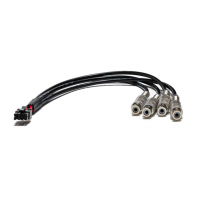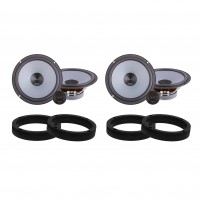Mosconi Gladen PICO 4 amplifier
4-channel amplifier of micro dimensions, 4 x 90 into 4 Ω / 4 x 120 W RMS into 2 Ω
More about the product
More about the product
We will help you with your purchase
- Use our consulting room
- You can return the goods to us within 14 days
- Try the product at our store
Mosconi Gladen PICO 4 amplifier
The Mosconi Gladen PICO 2.0 became a bit of a sensation in 2015. That's why Gladen decided to significantly expand this range with additional models of Mosconi Gladen PICO amplifiers. At the end of 2019, the new micro amplifier PICO 4 is coming to the market. Its dimensions are 150 x 115 x 46 mm, thanks to which it will not be a problem to find a suitable place in the car so that it hides and is not seen. PICO amplifiers use Class D technology.Key features of the Mosconi Gladen PICO 4 amplifier
- Four-channel broadband PWM amplifier with separate synchronized modulation.
- Total power up to 480 W RMS, bridgeable and stable 2 ohms.
- PICO 4 handles every configuration: whether classic front/rear speaker concepts, two subwoofers or subwoofers with a double voice coil.
- An ideal complement to the PICO DSP power amplifier, but can also be used on its own with a high and low level input and custom filters.
- Long lateral ribbing for optimal heat dissipation.
| Catalog number | PICO 4 |
| Brand | Mosconi Gladen |
| Links | Official web presentation |
| Number of amplifier channelsAmplifiers are divided into: - Monoblocks - 2-channel - 3-channel - 4-channel - 5-channel - 6-channel - multi-channel Each channel is used to power one speaker for the coaxial type, or one side if they are component speakers. Monoblock type amplifiers are mainly used for subwoofers. 2-channel are suitable for both subwoofers and, for example, the front pair of speakers in a car. 3-channel is used for front or rear speakers + subwoofer. 4-channel are used for front + rear speakers or 1 pair of speakers + subwoofer. 6 or 5-channel are used for 2 pairs of speakers + subwoofer, most often. Bridging means connecting the amplifier to a bridge, using the + pole from one channel and the - pole from the other channel. In most cases this is shown as "BRIDGED" on the amplifier. | 4 |
| Energy class of the amplifierAmplifiers are divided into two basic classes: analog and digital . Analog amplifiers (A/B) have higher consumption requirements, but usually have a more natural sound. Digital amplifiers (D) have significantly lower consumption and higher efficiency, but the sound may not be as faithful as with classic analog amplifiers. | D |
| RMS power into 4 ΩRMS power when loading speakers or subwoofer at 4 Ω. RMS power is the constant power of the amplifier and is one of the most important parameters when choosing an amplifier. | 4 x 90W |
| RMS power into 2 ΩRMS power when loading speakers or subwoofer at 2 Ω. RMS power is the constant power of the amplifier and is one of the most important parameters when choosing an amplifier. | 4 x 120W |
| High level inputsThe high-level input on the amplifier allows connection directly to the existing speakers in the car without additional purchase of an external high/low adapter. Important equipment in the case of installing an amplifier on an original car radio. | Yes |
| Automatic on and offThis function allows you to automatically switch on the amplifier. | Yes |
| Remote control included in the packageSome models of amplifiers also come with wired remote controls in the package, which on one side plug into the amplifier and on the other side you have a potentiometer that you can place anywhere in the cabin. A common place to place the remote control is under the steering wheel. The advantage is the regulation of power, and therefore volume, depending on driving conditions and the mood of the crew in the car. | No |
| The value of the fuses on the amplifierFrom the value of the fuses on the amplifier, you can get a true picture of the real performance of the amplifier. | 1 x 30 A |
| Dimensions of the amplifier | 150 x 115 x 46 mm |
| Mass | 1050 g |
Product comments
Evaluation
ask us



























